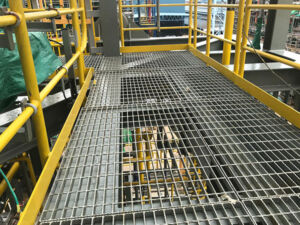Steel grating for nuclear power plant facilities is an essential component in ensuring safety and functionality. These gratings are designed to provide structural support while allowing for efficient drainage and ventilation. Their unique properties make them ideal for the demanding environments found in nuclear power plants, where reliability and durability are paramount.
The primary function of steel grating in nuclear facilities is to support heavy equipment and personnel while maintaining safety standards. The open design of the grating allows for quick drainage of water and other fluids, minimizing the risk of slip hazards. Additionally, steel grating is resistant to corrosion, making it suitable for the harsh conditions often present in nuclear environments.
When selecting steel grating for nuclear power plant facilities, several factors must be considered. First, the load-bearing capacity of the grating must meet the specific requirements of the installation. This includes considering the weight of equipment, personnel, and any additional loads that may be present. Furthermore, the spacing of the grating bars must be appropriate to prevent small objects or personnel from falling through.
Another critical aspect to consider is the material composition of the steel grating. High-quality, galvanized steel is often used to enhance corrosion resistance and prolong the lifespan of the grating. Some facilities may also opt for stainless steel options, which provide superior resistance to rust and degradation, especially in areas exposed to moisture and chemicals.

In addition to material properties, the manufacturing process of steel grating plays a significant role in its performance. The grating must be fabricated to precise specifications to ensure it meets industry standards. This includes proper welding techniques, surface treatments, and finishing processes to enhance durability and safety.
The installation of steel grating in nuclear power plant facilities requires careful planning and execution. It is essential to follow the guidelines set forth by regulatory bodies to ensure compliance with safety standards. Proper installation not only enhances the effectiveness of the grating but also contributes to the overall safety of the facility.
Maintenance of steel grating is another crucial consideration for nuclear facilities. Regular inspections should be conducted to identify any signs of wear or damage. Prompt repairs or replacements can prevent potential hazards and ensure the continued safety of the facility. Establishing a maintenance schedule is vital to uphold the integrity of the grating over time.
In recent years, advancements in technology have led to the development of innovative steel grating designs. These new products often incorporate features such as slip-resistant surfaces and enhanced load capacities. By staying up-to-date with the latest advancements, nuclear power plants can ensure they are utilizing the best materials available for their facilities.
The environmental impact of steel grating production and usage is also an important consideration. Many manufacturers are now focusing on sustainable practices, such as using recycled materials and minimizing waste during production. These efforts not only benefit the environment but can also lead to cost savings for nuclear facilities.
Furthermore, the aesthetic aspect of steel grating should not be overlooked. While functionality is the primary concern, the visual appeal of the grating can also play a role in the overall design of the facility. Options for powder coating or painting the grating can enhance its appearance while providing additional protection against corrosion.
Collaboration between engineers, architects, and safety professionals is essential in the selection and implementation of steel grating for nuclear power plant facilities. This interdisciplinary approach ensures that all aspects of safety, functionality, and design are considered. Regular communication among team members can lead to better outcomes and more efficient processes.
Training personnel on the proper use and maintenance of steel grating is vital. Employees should be educated about the importance of maintaining the grating and recognizing potential hazards. This knowledge can help foster a culture of safety within the facility, ultimately leading to a safer working environment.
The economic implications of using steel grating in nuclear power plants are significant. While the initial investment may be higher than other materials, the long-term benefits of durability and reduced maintenance costs can lead to substantial savings. Additionally, the safety provided by high-quality steel grating can prevent costly accidents and downtime.
Global standards and regulations govern the use of steel grating in nuclear facilities. Compliance with these regulations is non-negotiable, as failure to adhere can result in severe penalties and safety risks. Understanding these standards is crucial for facility managers and engineers involved in the selection and installation of steel grating.
As the nuclear energy sector continues to evolve, so too will the materials used in its facilities. Steel grating manufacturers are expected to innovate further, developing products that enhance safety, efficiency, and sustainability. Keeping abreast of industry trends will be essential for those involved in the nuclear power sector.
In conclusion, steel grating for nuclear power plant facilities is a critical component that impacts safety, functionality, and overall efficiency. By choosing the right materials, ensuring proper installation, and maintaining the grating, facilities can uphold the highest safety standards. As technology advances, the future of steel grating will likely bring even more improvements that benefit the nuclear energy industry.
The role of steel grating extends beyond just structural support; it also contributes to the overall safety culture within nuclear facilities. By prioritizing quality and compliance, plant managers can promote a safer working environment for all personnel. As the industry continues to grow, so will the importance of high-quality materials like steel grating.
Ultimately, the decision to use steel grating in nuclear power plant facilities should be informed by thorough research and collaboration among stakeholders. The long-term benefits of investing in high-quality, durable materials will far outweigh the initial costs, ensuring that facilities operate safely and efficiently for years to come.

